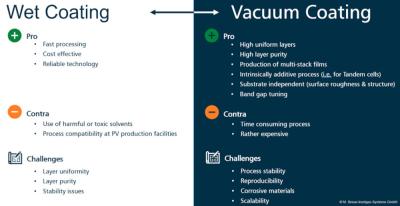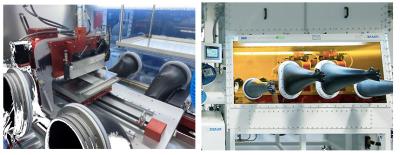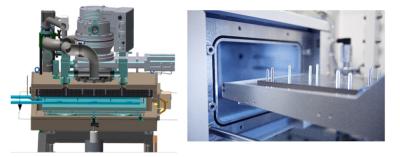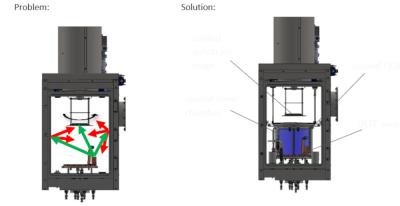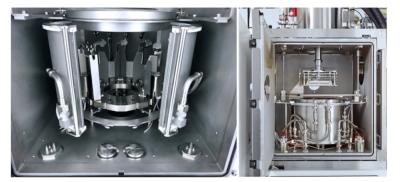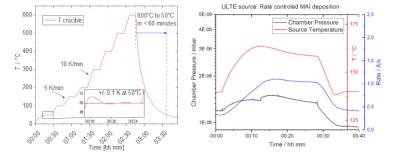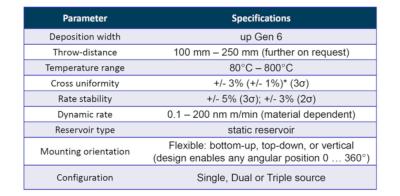This is a sponsored post by MBRAUN
The potential of perovskites
Over the past decade, perovskites solar cells have attracted tremendous interest from the academic community, becoming a leading photovoltaic trend. Advances in the fundamental understanding of perovskites’ chemical and physical processes made them an attractive class of material for many researchers. In parallel, engineering developments on the architecture and fabrication methods of perovskite-based solar cells are becoming increasingly interesting for the PV industry.
Processing of perovskites
In general, three main types of perovskites processes can be distinguished – the fully vacuum-processed, the fully ambient processed and the hybrid type. For each process, MBRAUN can offer dedicated equipment solutions which will be showed in outline in the following paragraphs.
On one hand vacuum-based methods convince due to high-quality thin films, leading to the best device performance but are but are also characterized by comparatively high investment and operating costs. On the other hand, solution-processing techniques, like spin coating or slot-die coating also produce good-quality layers but excel at significantly lower investment and operation costs.
Comparison of wet and vacuum coating
Wet coating solutions
For wet coating processes, slot-die coating becomes one of the most attractive and state of the art coating process due its easy and efficient scalability from laboratory results into production scale. In close cooperation, FOM Technology, a leading manufacturer of slot die coating equipment, and MBRAUN, are offering turnkey solutions for glovebox integrated coating equipment which are perfectly aligned with the increasing demands of state-of-the-art research.
Depending on the cell-design roll-to-roll and sheet-to-sheet equipment is available allowing it to coat on both rigid (e.g. silicon wafers or glass encapsulation) and flexible (e.g. PET foil) substrates. Currently the research is mainly based on manually operated system setups but to increase throughput, to prove the manufacturing capability of perovskites and to eliminate human error in the research process, system concepts with automated material transfer are getting popular in industrial and university-based research groups.
FOM slot-die coating machine in MBRAUN glovebox
For solution processed materials dedicated curing solutions are required and currently about to be established in the market. Typically, the curing is accomplished by thermal treatment of the deposited layers under defined vacuum conditions. The process conditions are highly dependent on the solvent type, the solid material content of the ink and need to be determined for each device stack individually. Both processes – curing and coating – are highly interconnected. When both processes are balanced, dry-film thicknesses between 20 nm up to 250 µm at uniformities of up to ±2% can be achieved.
VCD system for perovskite curing
Typical vacuum sequence during VCD
Vacuum coating technology
Vacuum processed perovskites on the other hand require dedicated solutions addressing the physical and chemical properties of the used materials. Some of these chemical compounds are highly corrosive so system concepts are required to prevent damages to critical components of the coating equipment. In addition, commonly used materials such as Methylammonium iodide (MAI) require novel system designs addressing the low boiling point of these compounds. The high vapour pressure of these materials results in an uncontrolled evaporation even at room temperature and even re-evaporation from process chamber walls.
To get all the process under control MBRAUN and CreaPhys developed a unique and patented PVD system which allows unmatched process control to achieve repeatable coating results.
re-evaporation effect in standard vacuum system (left) compared to the PEROvap System (right)
Main features of state-of-the-art PVD-tool designs for perovskite deposition (PEROvap - patented) incorporate ULTE sources (Ultra Low Temperature Evaporator), a cooled inner process chamber and cooled QCMs (Quartz Crystal monitors). To reach a stable and highly repeatable process the temperature of these components is controlled typically in a range of -10°C to -40°C.
PEROvap system (patented) with cooled process chamber
Characteristics of LTE source
To take the step from laboratory to industrial scale other source designs are required. The first systems which aim for scaling-up research results into pilot-scale manufacturing are currently being designed and installed at leading institutes and industrial partners. Core element of these complex machines are linear sources which allow coatings widths of >1200 mm. These sources do show the same characteristics as their smaller ULTE sources but are in this case designed for 24/7 operation. High performance ceramics, a sophisticated heat management system and a modular design allow to keep the demanding requirements in industrial manufacturing environments.
Typical specification of linear source
What is next for perovskites?
The development of perovskite solar cells has been remarkable over the last decade. This development will likely accelerate in the coming years due to extensive funding available to combat climate change, where solar energy plays an important role. Research activities are likely to focus on reducing the layer’s defects, identifying new, more environmentally friendly materials, and improving long-term device durability. MBRAUN and its partners will continue to support our academic customers in their R&D needs for innovative PeroVap systems and flexible slot-die-coating machines and keeping our corporate customers to pave the way to large-scale production with next generation linear sources.
For more information on perovskite solutions from MBRAUN, click here
